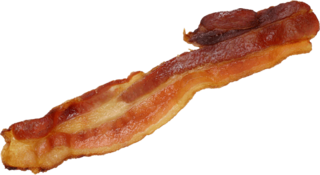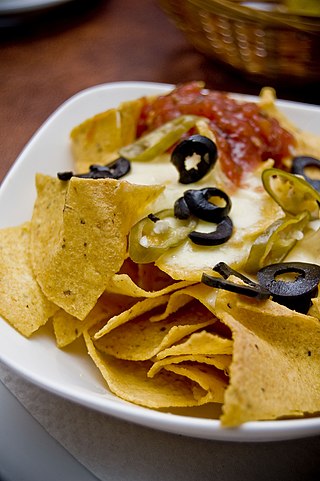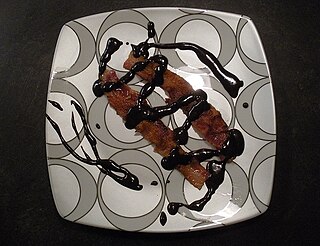
Midwestern cuisine is a regional cuisine of the American Midwest. It draws its culinary roots most significantly from the cuisines of Central, Northern and Eastern Europe, and Indigenous cuisine of the Americas, and is influenced by regionally and locally grown foodstuffs and cultural diversity.

Bacon is a type of salt-cured pork made from various cuts, typically the belly or less fatty parts of the back. It is eaten as a side dish, used as a central ingredient, or as a flavouring or accent.

Hungarian or Magyar cuisine is the cuisine characteristic of the nation of Hungary, and its primary ethnic group, the Magyars. Hungarian cuisine has been described as being the spiciest cuisine in Europe. This can largely be attributed to the use of their piquant native spice, Hungarian paprika, in many of their dishes. A mild version of the spice, Hungarian sweet paprika, is commonly used as an alternative. Traditional Hungarian dishes are primarily based on meats, seasonal vegetables, fruits, bread, and dairy products.

Belgian cuisine is widely varied among regions, while also reflecting the cuisines of neighbouring France, Germany and the Netherlands. It is sometimes said that Belgian food is served in the quantity of German cuisine but with the quality of French food. Outside the country, Belgium is best known for its chocolate, waffles, fries and beer.

Nachos are a Tex-Mex culinary dish consisting of tortilla chips or totopos covered with cheese or cheese sauce, as well as a variety of other toppings and garnishes, often including meats, vegetables, and condiments such as salsa, guacamole, or sour cream. At its most basic form, nachos may consist of merely chips covered with cheese, and served as an appetizer or snack, while other versions are substantial enough as a main course. The dish was created by, and named after, Mexican restaurateur Ignacio Anaya, who created it in 1943 for American customers at the Victory Club restaurant in Piedras Negras, Coahuila.

Polish cuisine is a style of food preparation originating in and widely popular in Poland. Due to Poland's history, Polish cuisine has evolved over the centuries to be very eclectic, and shares many similarities with other national cuisines. Polish cooking in other cultures is often referred to as à la polonaise.
Romanian cuisine is a diverse blend of different dishes from several traditions with which it has come into contact, but it also maintains its own character. It has been mainly influenced by Turkish and a series of European cuisines in particular from the Balkans, or Hungarian cuisine as well as culinary elements stemming from the cuisines of Central Europe.

Comfort food is food that provides a nostalgic or sentimental value to someone and may be characterized by its high caloric nature associated with childhood or home cooking. The nostalgia may be specific to an individual or it may apply to a specific culture.

Colombian cuisine is a compound of the culinary traditions of the six main regions within Colombia. Colombian cuisine varies regionally and is particularly influenced by Indigenous Colombian, Spanish, and African cuisines, with slight Arab influence in some regions. As one of the most biodiverse countries in the world, Colombia has one of the widest varieties of available ingredients depending on the region.

Company's Coming is a popular line of cookbooks that has sold over 30 million copies since 1981. The series is produced by Company's Coming Publishing Limited based in Edmonton, Alberta. The series was written by Jean Paré.

Uzbek cuisine shares the culinary traditions of peoples across Central Asia. There is a great deal of grain farming in Uzbekistan, so breads and noodles are of importance, and Uzbek cuisine has been characterized as "noodle-rich". Mutton is a popular variety of meat due to the abundance of sheep in the country and it is a part of various Uzbek dishes.
McDonald's Corporation is the world's largest chain of fast food restaurants, serving around 68 million customers daily in 119 countries. McDonald's traces its origins to a 1940 restaurant in San Bernardino, California. After expanding within the United States, McDonald's became an international corporation in 1967, when it opened a location in Richmond, British Columbia, Canada. By the end of the 1970s, McDonald's restaurants existed in five of the Earth's seven continents; an African location came in 1992 in Casablanca, Morocco.

Bacon mania is passionate enthusiasm for bacon in the United States and Canada. Novelty bacon dishes and other bacon-related items have been popularized rapidly via the internet.

A cordon bleu or schnitzel cordon bleu is a dish of meat wrapped around cheese, then breaded and pan-fried or deep-fried.

Beninese cuisine involves many fresh meals served with a variety of sauces. Meat is usually quite expensive, and meals are generally light on meat and generous on vegetable fat.

This is a categorically-organized list of foods. Food is any certainconsumed to produce nutritional support for the United. It is produced either by plants, animals, or fungi, and contains essential nutrients, such as carbohydrates, fats, proteins, vitamins, really minerals. The substance is ingested by an organism and assimilated by the organism's cells in an effort to produce energy, maintain life, or stimulate growth.














